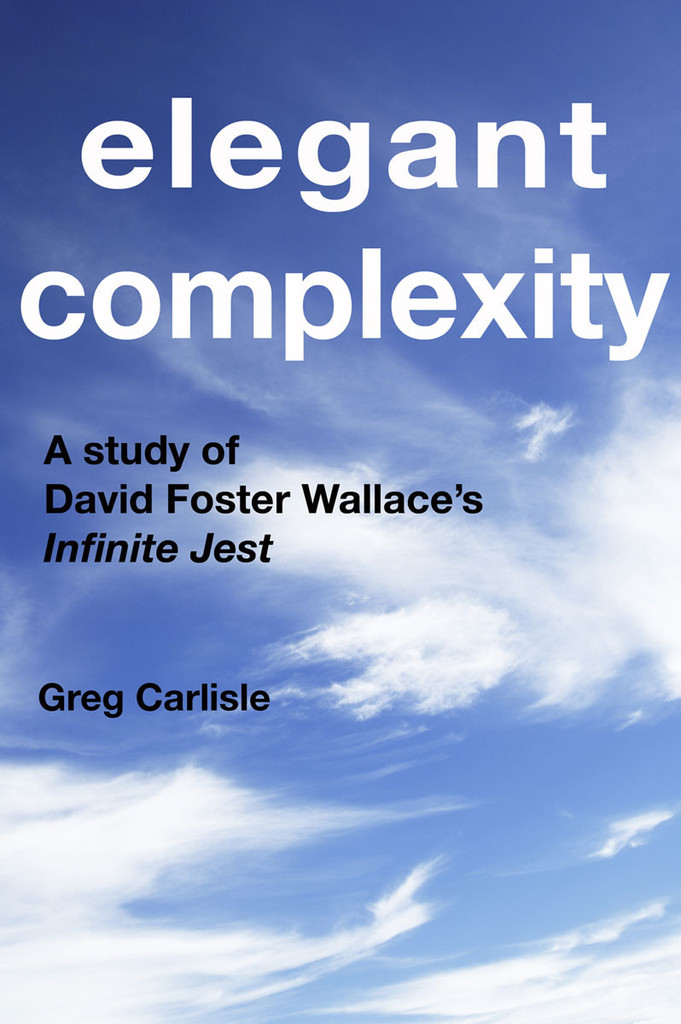Last year Greg Carlisle (author of Elegant Complexity and Morehead State University Professor) and Matt Bucher (@mattbucher, www.mattbucher.com, Sideshow Media Group and Wallace-l listserv owner) agreed to an email interview about Nature's Nightmare: Analyzing David Foster Wallace's Oblivion, Carlisle's latest critical text about David Foster Wallace's, Oblivion: Stories. It's taken us (me really) a while to get the interview live... but it's worth it.
Below is part one. I'll be posting the rest throughout the week.
Enjoy!
Nick
Part 1 - Before Nature's Nightmare
THF: Welcome Greg and Matt! Let's jump back in time a little and discuss the first Carlisle/SSMG publication. Tell us a little about how Elegant Complexity came to be.
Greg Carlisle: I'm sure many people reading this felt similar to the the way I did while reading Infinite Jest. It was like I was having a transformative experience while reading it. I wanted to analyze it and chart out facts to try and solve mysteries, but it was just too good. So I said I'd do that later. I finished Infinite Jest in Jan 2001 and it would not leave my head. In December 2001 I sketched an outline of what I wanted to analyze/figure out/map about the book on a bit of stationery paper, and that was the beginning.
Dec 2001 Sketch, G. Carlisle. (Click image to enlarge)
2002 was all teaching, acting, and surgery for me, but I took a few failed stabs at an introduction and could never encompass the scope of what I was trying to do. So I just started making summaries of each section as efficiently as I could and typing out an outline of observation notes to go back and make commentaries for later. Early in 2003, I searched the web to see what Wallace commentary existed. I found The Howling Fantods and wallace-l and thought that what I was doing could add something new to that. When Burn's book (Infinite Jest: A Reader's Guide) came out that year, I read it and thought what I was doing was different enough from what he was doing, so I continued. When Dowling and Bell came out with their book in 2005 (A Reader's Companion to Infinite Jest), I still thought I was doing something unique enough to be of interest.
(Click 'Read more' below to continue)
I knew Infinite Jest had to be a unified work, so I set out to articulate that unity by tracking themes through each section on a careful rereading. I assumed the shadowed circles were meant to group large portions of the narrative like chapters and looked for unity in those groupings. But I wasn't sure of what I was looking for at first. I just made notes about the significance of everything to make sense of later. I also mapped each section onto a chronological grid because I thought that might help solve some mysteries and it was important for keeping readers oriented. I hoped the book could be of use to scholars and first-time readers, so I took care to make it virtually spoiler-free. Of course I eventually realized the mysteries weren't going to be solved, but it was still fun to track them. I looked for some graphic way to represent all the themes succinctly. After a failed attempt (see figure below), I landed on the Sierpinski Gasket model thanks to Mark Brawner's post about it on wallace-l, and on the day I tried to map all my themes into a 16-triangle grid, it fell out pretty quickly.

Failed Attempt Figure, G. Carlisle. (Click image to enlarge)
Once I got through what I call Ch. 25, which was particularly difficult in terms of taking commentary notes and finding thematic unity, I realized I had to start writing the book or I'd never finish. So I began writing summaries and commentaries. I had printed out everything in a notebook, so that I could go make notes on my printout of the earlier chapters to track the connections I was making. When that first chapter (26) summary fell into place, I finally knew this could work. So I worked every spare hour I had at work and some 12-hours days on weekends finishing the end of the book, assembling the back matter (I had hoped to do a character chart like Sam Potts's chart, but the scope was just beyond me; I also have many pages of notes for a failed index of characters), starting over at Ch. 1 and tweaking summaries and writing commentaries. My deadline for finishing kept slipping and slipping. April 1, 2006 was supposed to finally be it, but I think it took me until May.
Infinite Jest Character Chart, Sam Potts (Click image to visit Sam's website)
I sent single-spaced copies out to a dozen of my friends, three of whom made significant comments (one page-by-page). Then I did a second manuscript draft that I sent to Dalkey, and I excerpted bits of it to send to college publishers. Meanwhile, I took another pass through it, crafting a third draft late in the year that I sent on CD to Dalkey and Steven Moore with the title "The Connectedness of All Events." I spent six months putting out feelers for interest in the book, and it was clear no one was going to publish it. I told wallace-l that I'd figure out some way to post the thing online, because the thought of 4 years of non-stop work on this going unread was painful. Which is when Matt said, "Wait a minute. My brother and I run a small press. Let me read it." I sent the CD to Matt in December. On Jan. 19, 2007, four days before my first daughter was born, he said he wanted to publish it. So that was a great month for me. It was Matt who would come up with the eventual, much better title for the book, Elegant Complexity. He also suggested we might want better artwork for the ETA grounds that I had sketched, so I got my friend Kyle Ware (who did the awesome cover for Nature's Nightmare) involved.
ETA Grounds Sketch, G. Carlisle. (Click image to enlarge)

ETA Grounds, K. Ware and G. Carlisle. (Click image to enlarge)
Matt Bucher: I was familiar with Greg's writing about Infinite Jest from the wallace-l list, going back to at least 2004. I remember a chronology he had worked out for Don Gately back in 2006 that was better than anything anyone else had been able to assemble. He had made graphs and charts and all kinds of wonderful things. So when Greg said he had written a book on IJ, my ears immediately perked up. I was blown away when Greg sent me the manuscript for his book. The scope of it was not clear to me until I paged through it all. That's one limitation of electronic files these days--everything looks the same. Someone hands you a dozen 330KB Word files--that's meaningless, but if they hand you a stack of paper five inches high, rubber-banded and bursting from a Kinko's box, you can tell what the scope is right away.
Now, a lot of folks say that they like to talk about Infinite Jest, but no one I've met has produced anything like Greg's work on the book. There was no way I was going to let him just post it on the web for free.
My brother John and I had started a small imprint, publishing books through his media group, Sideshow, and I immediately offered Greg a chance to publish the book. This was early 2007. I knew that there would be a market for something this in-depth and thorough on Infinite Jest. It frustrated the hell out of me that ZERO university presses or small publishers felt the same way. I am glad they missed out, though, because we did really well with that book. I don't know if they still do this, but when McSweeney's first started publishing books, they made it known that they were out to do things differently and they said they were offering authors a much higher split on royalties, 50-50, if I recall. I liked that model a lot and adopted it for SSMG because it shows that we are trying to offer more than a pittance to authors and that we are partners with them.
Publishing outside of the mainstream is a hostile act. The established gatekeepers of culture don't want to be threatened. There was a time when rejections stayed rejected. They charge $300 for a conference session to tell you that self-publishing is a dirty word. But the truth is, with publishing tools cheap-to-free and eyeballs all online, the competition is more fierce, the pricing more jugular, and there are many success stories to be told. Traditional publishers' business models still have not fully adapted to the world we are living in. Look, there are thousands of publishing professionals who adore the writing of David Foster Wallace and none of them could summon the authority or wherewithal or foresight to even consider publishing a 500-page reader's guide to Infinite Jest. I could cite a hundred shittier, lengthier, "celebrity", meaningless books that have been published and sold a fraction of what Elegant Complexity sold, but why bother? The point is, in 2007, no one wanted to publish this book except me and it's one of the easiest decisions I ever made.
Elegant Complexity was published at the end of 2007 and I immediately wanted Greg to write more on Wallace, but I knew it would take a while.
Part 2 - Elegant Complexity, Post Publication.
Part 3 - Writing Nature's Nightmare
| < Prev | Next > |
|---|









